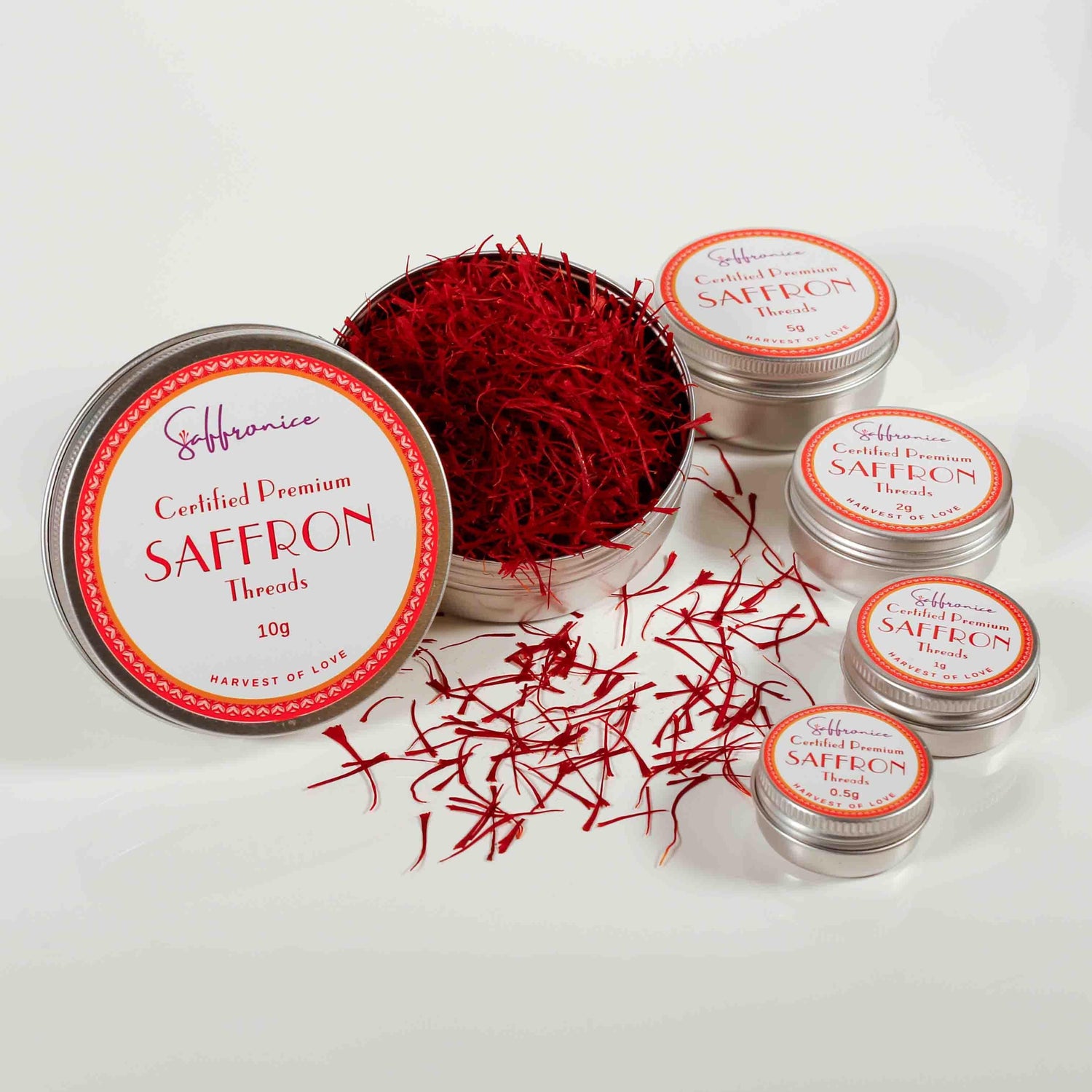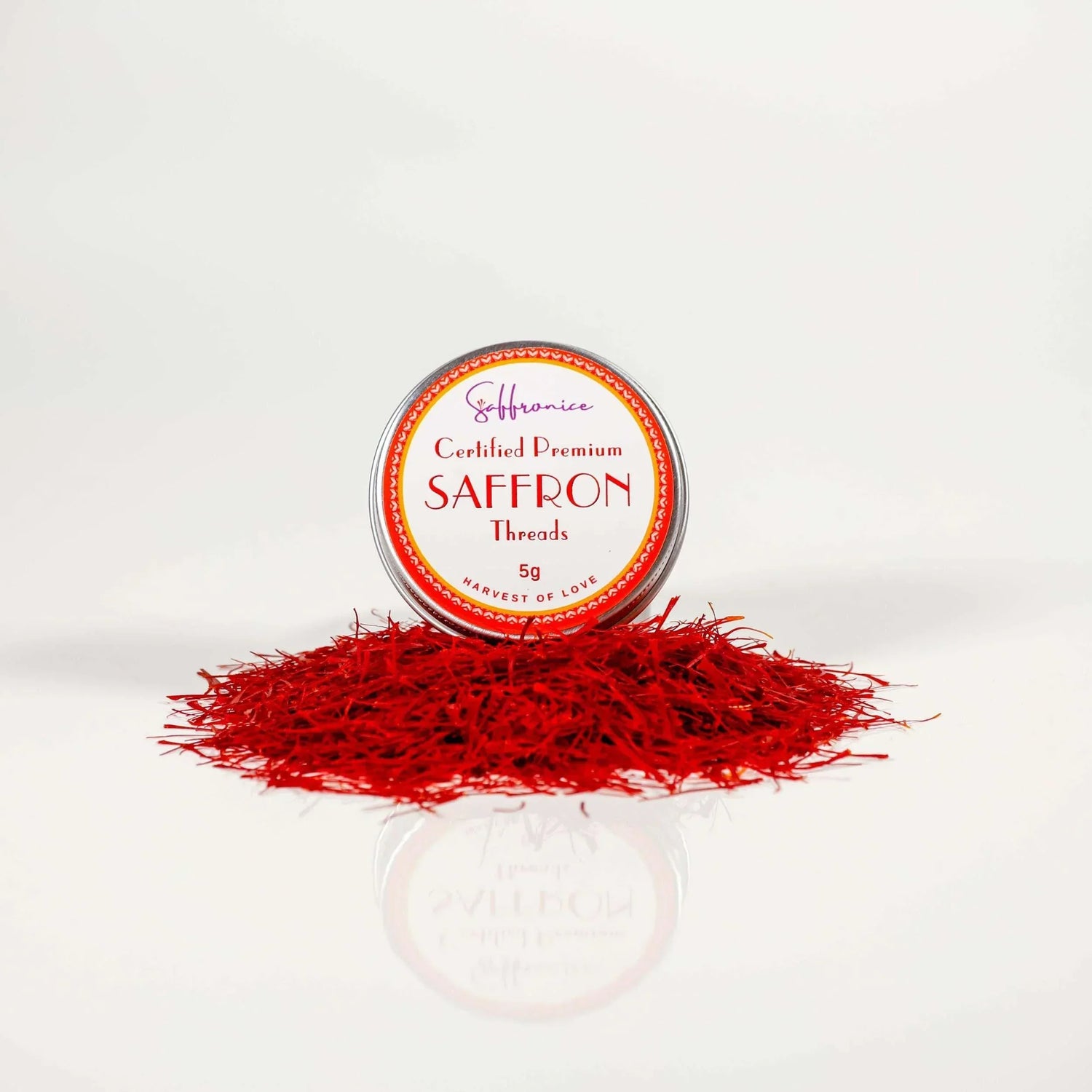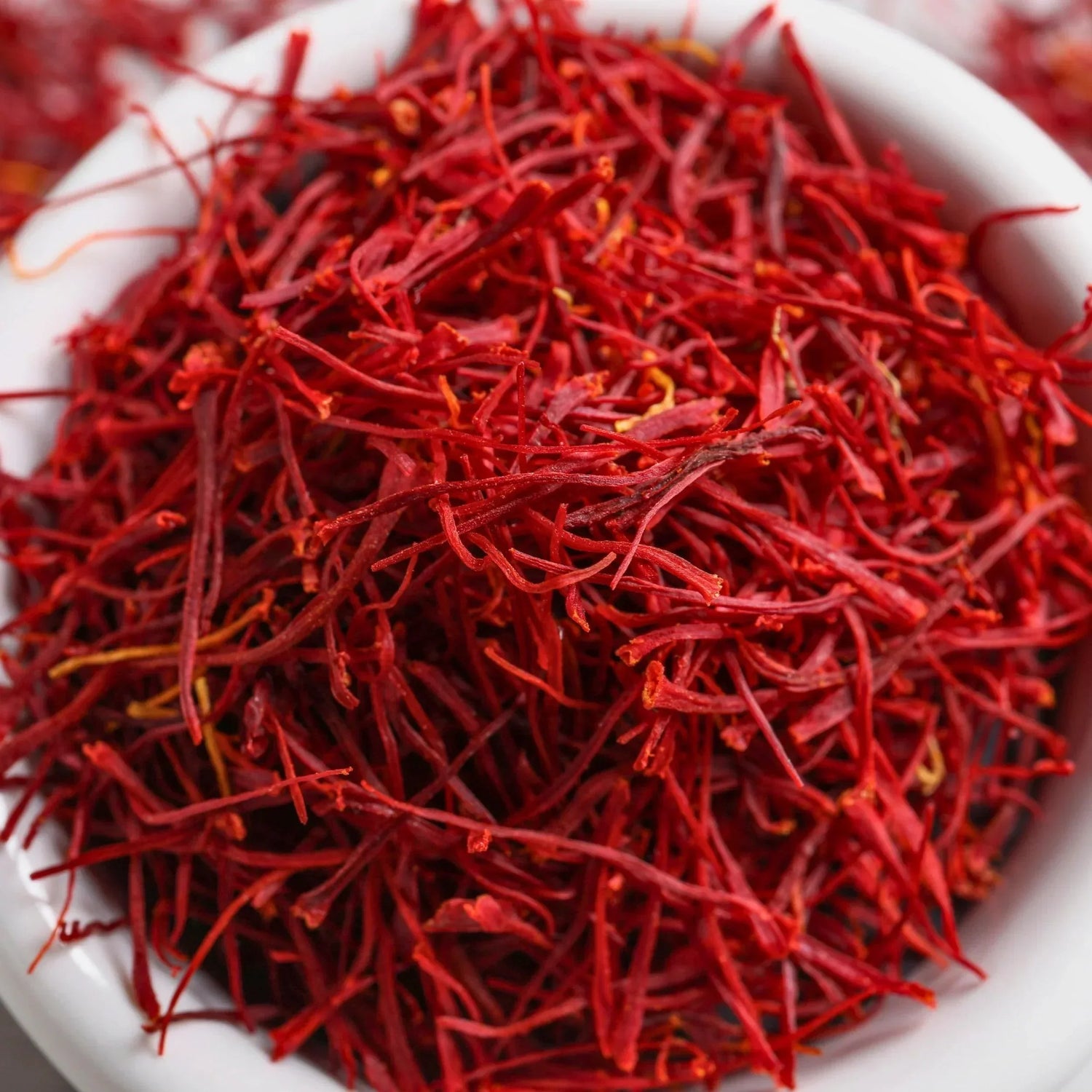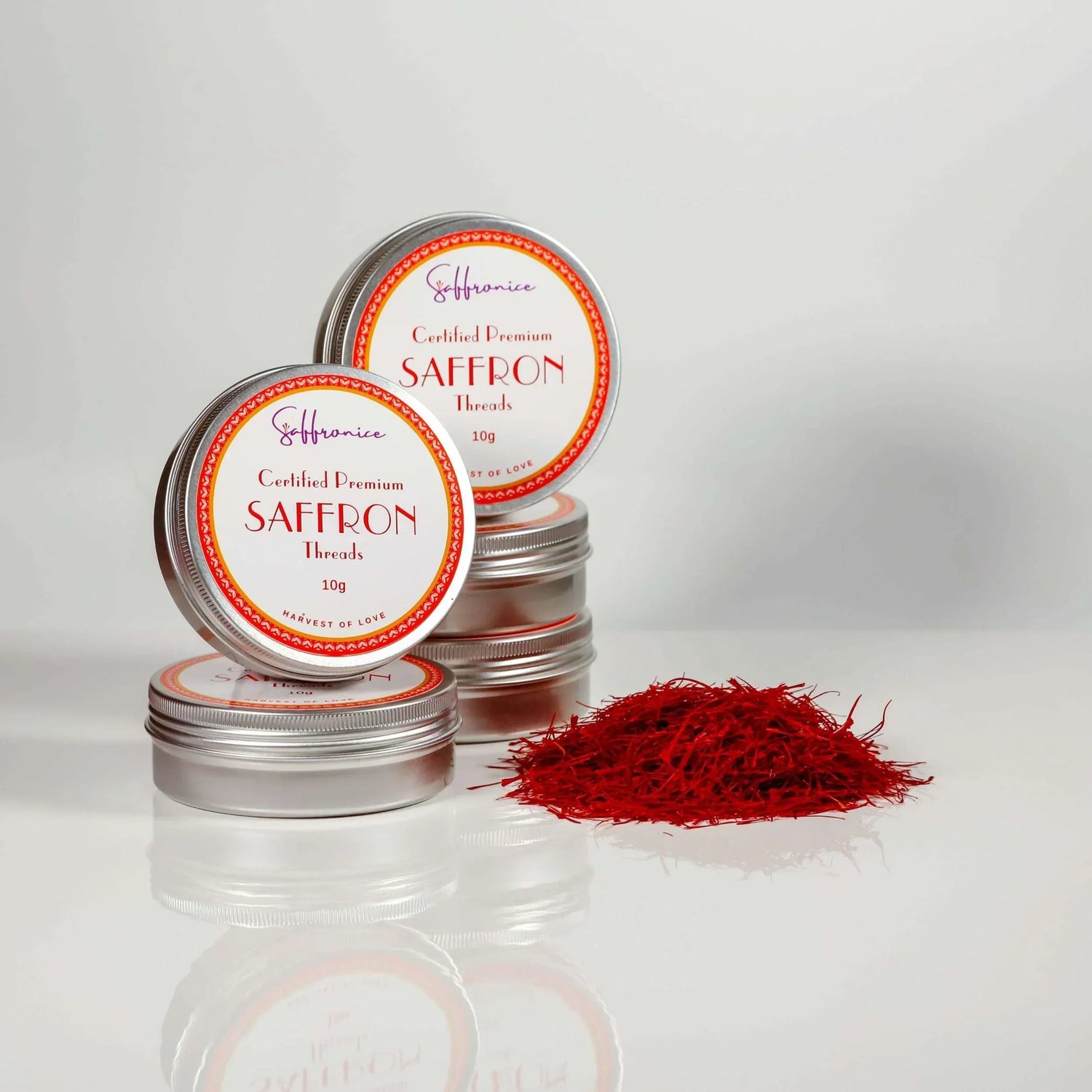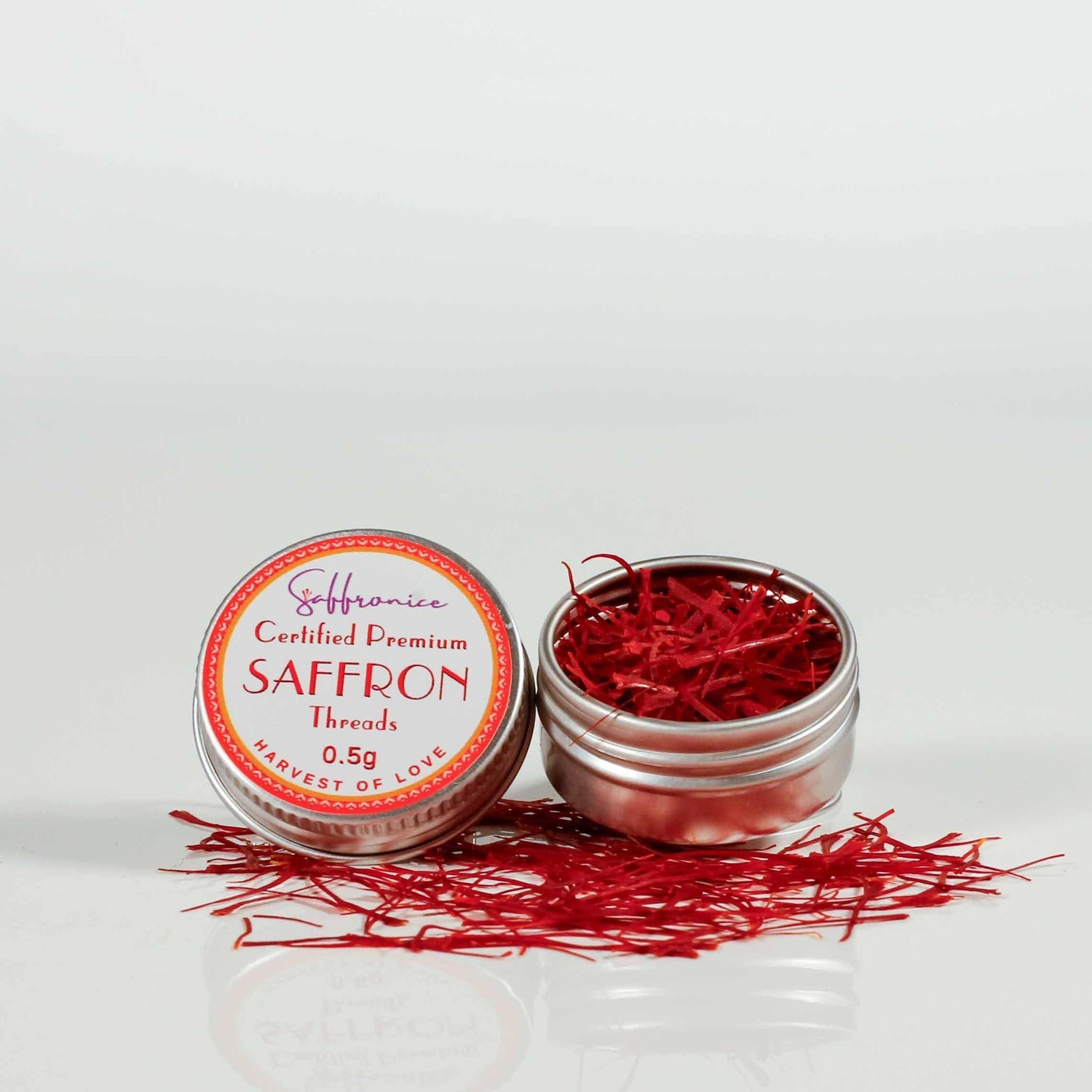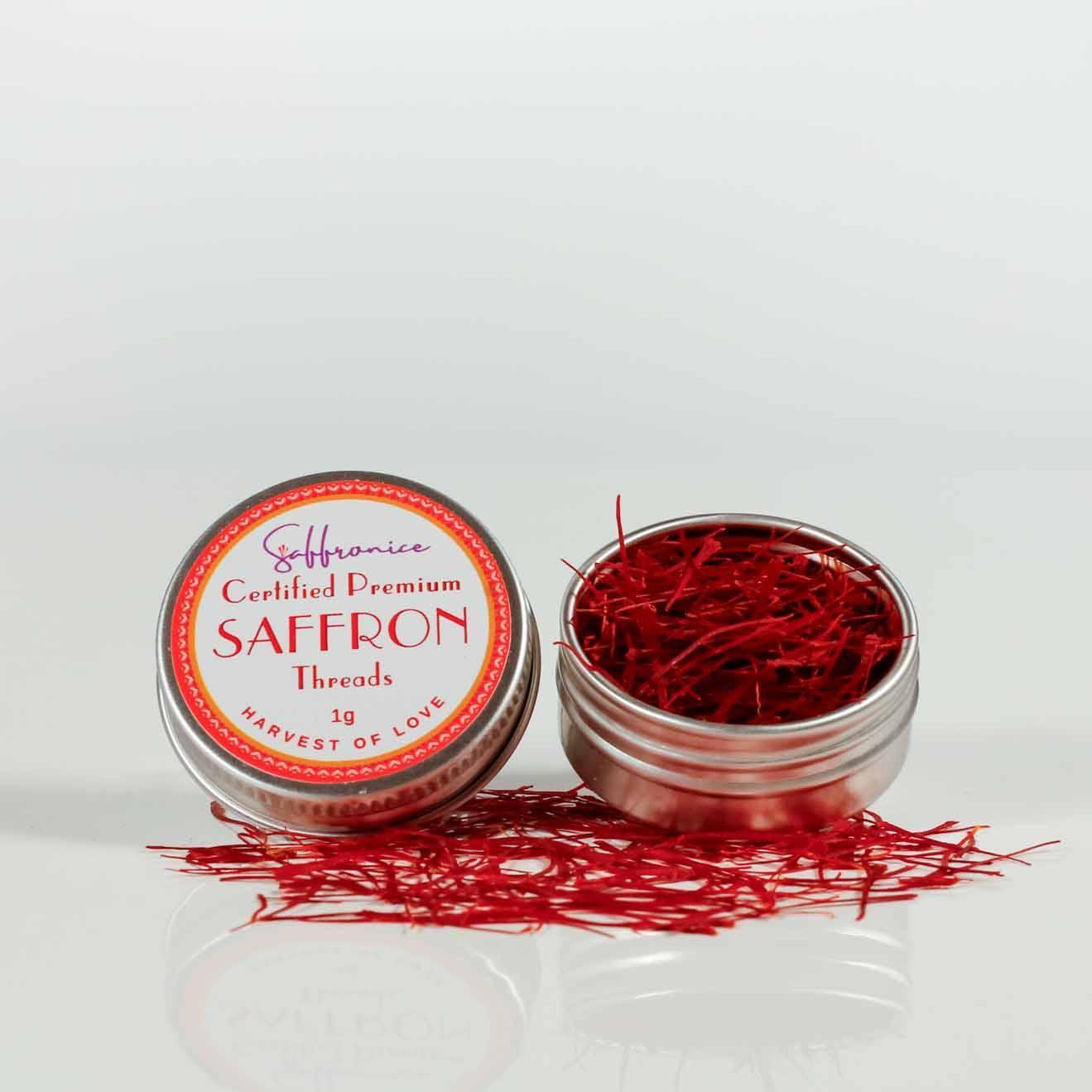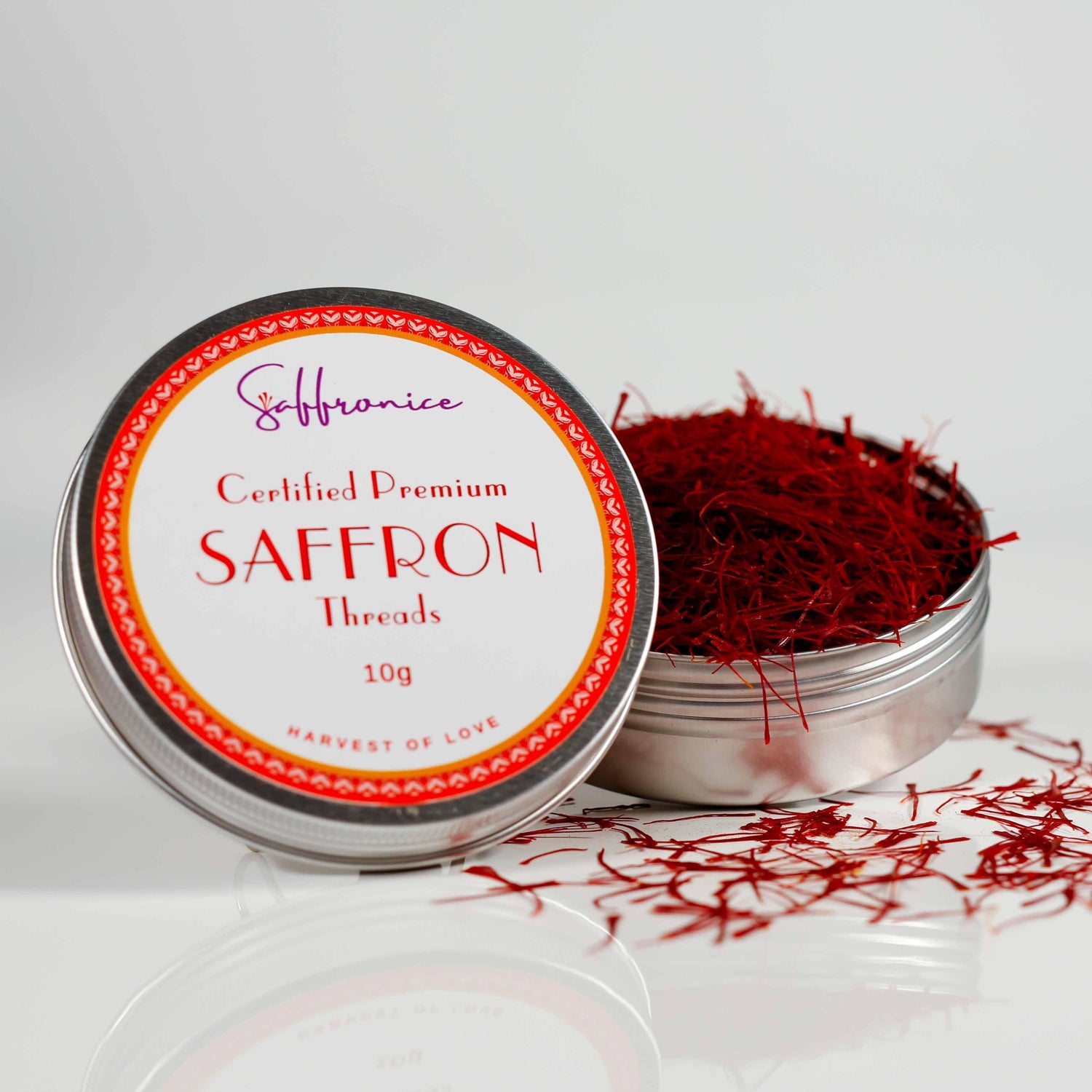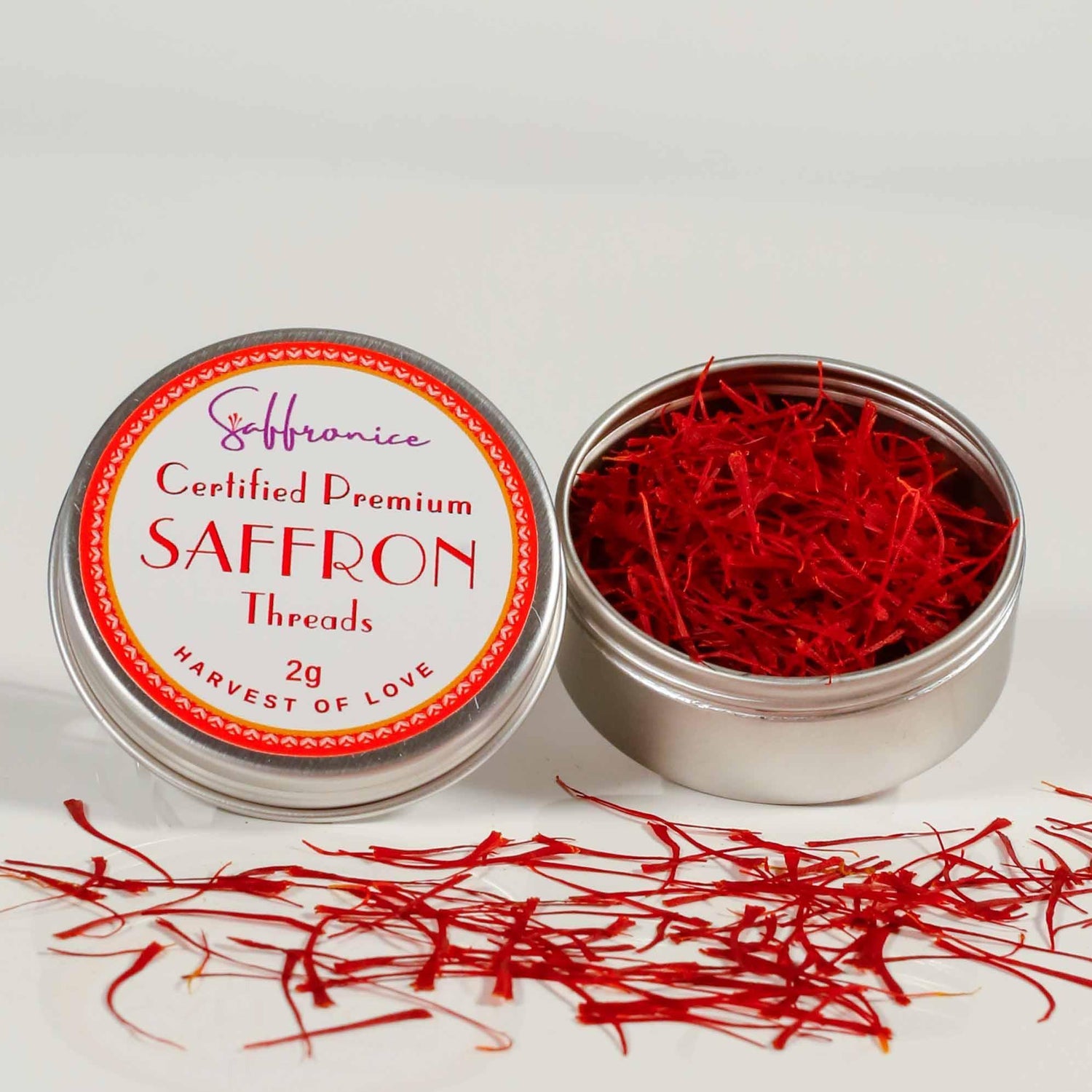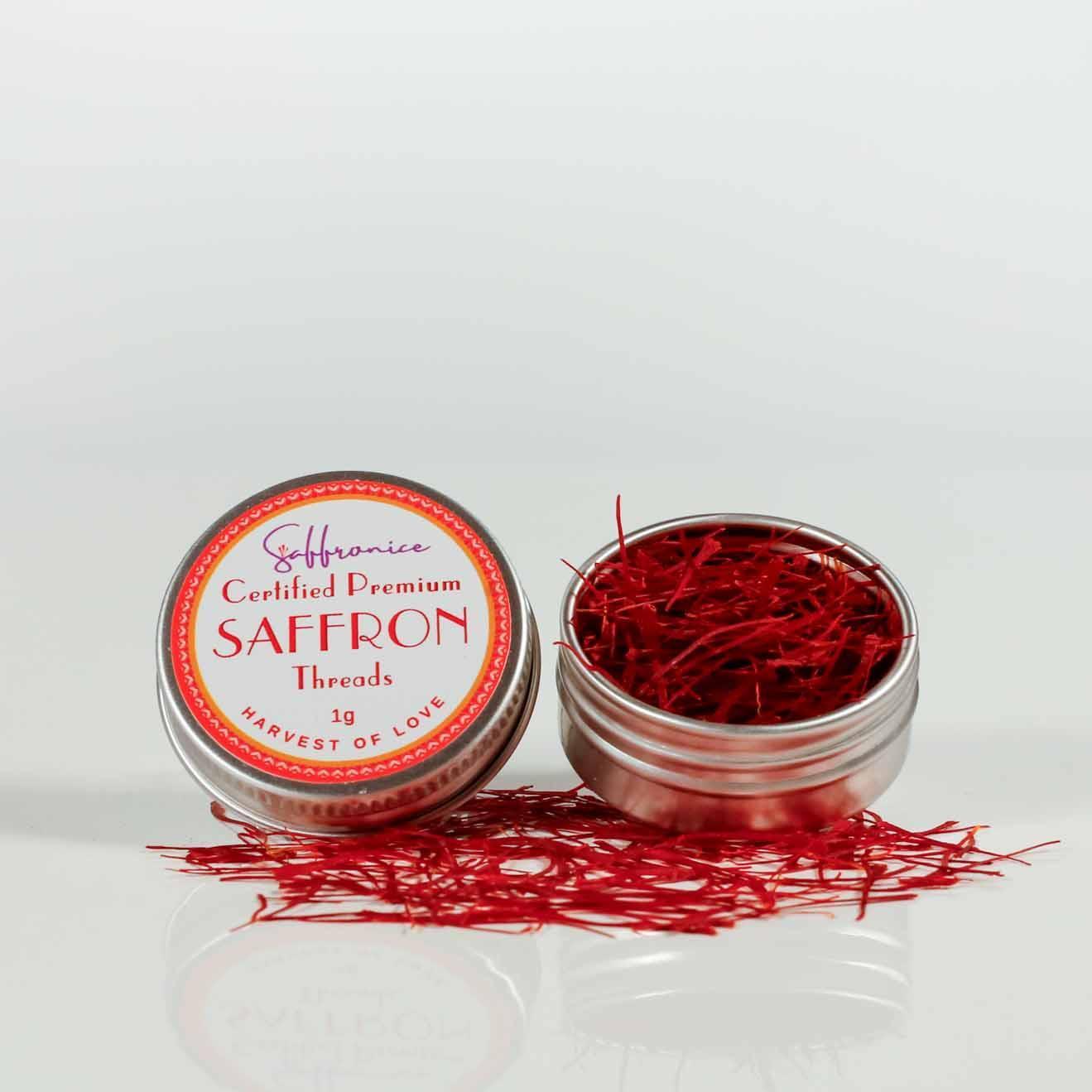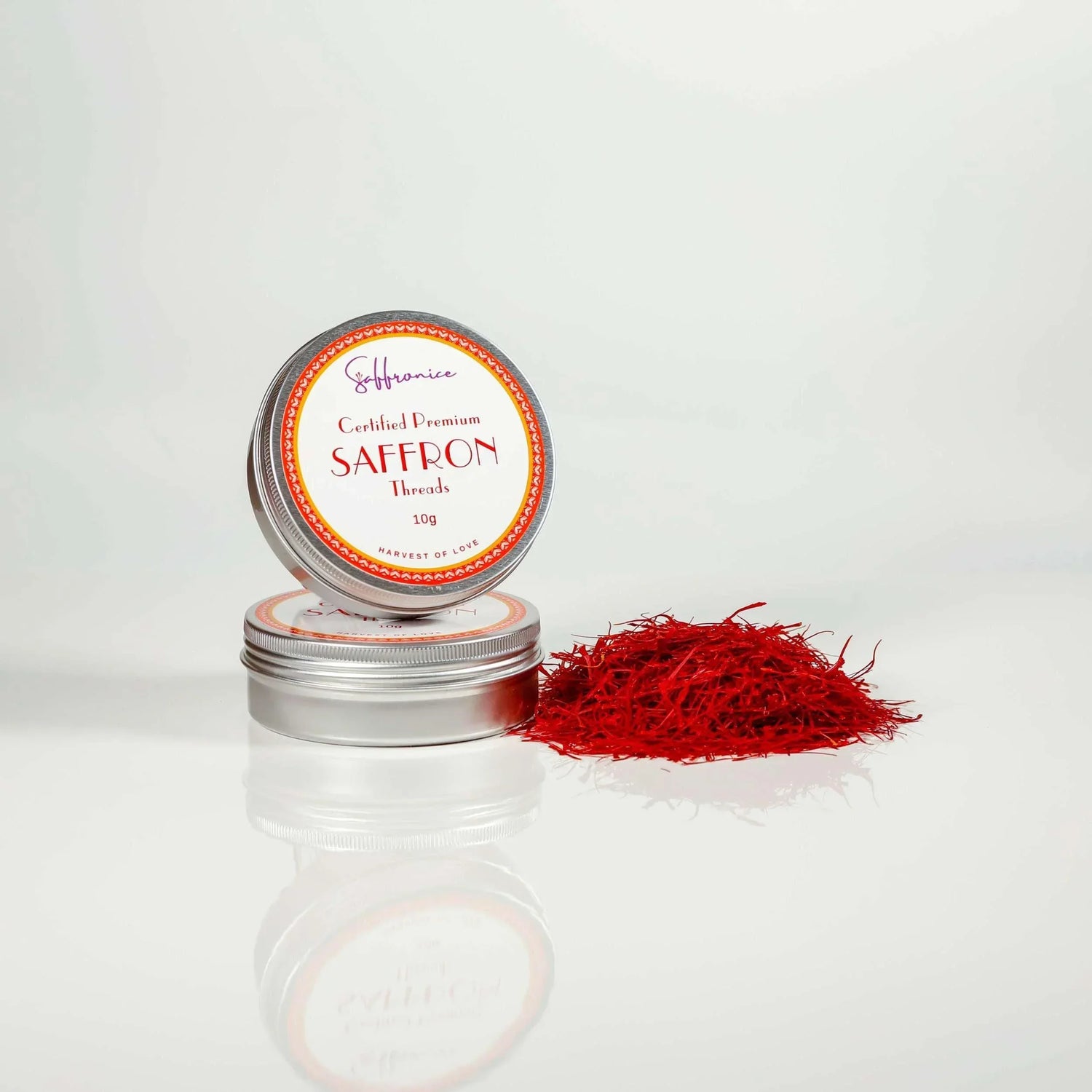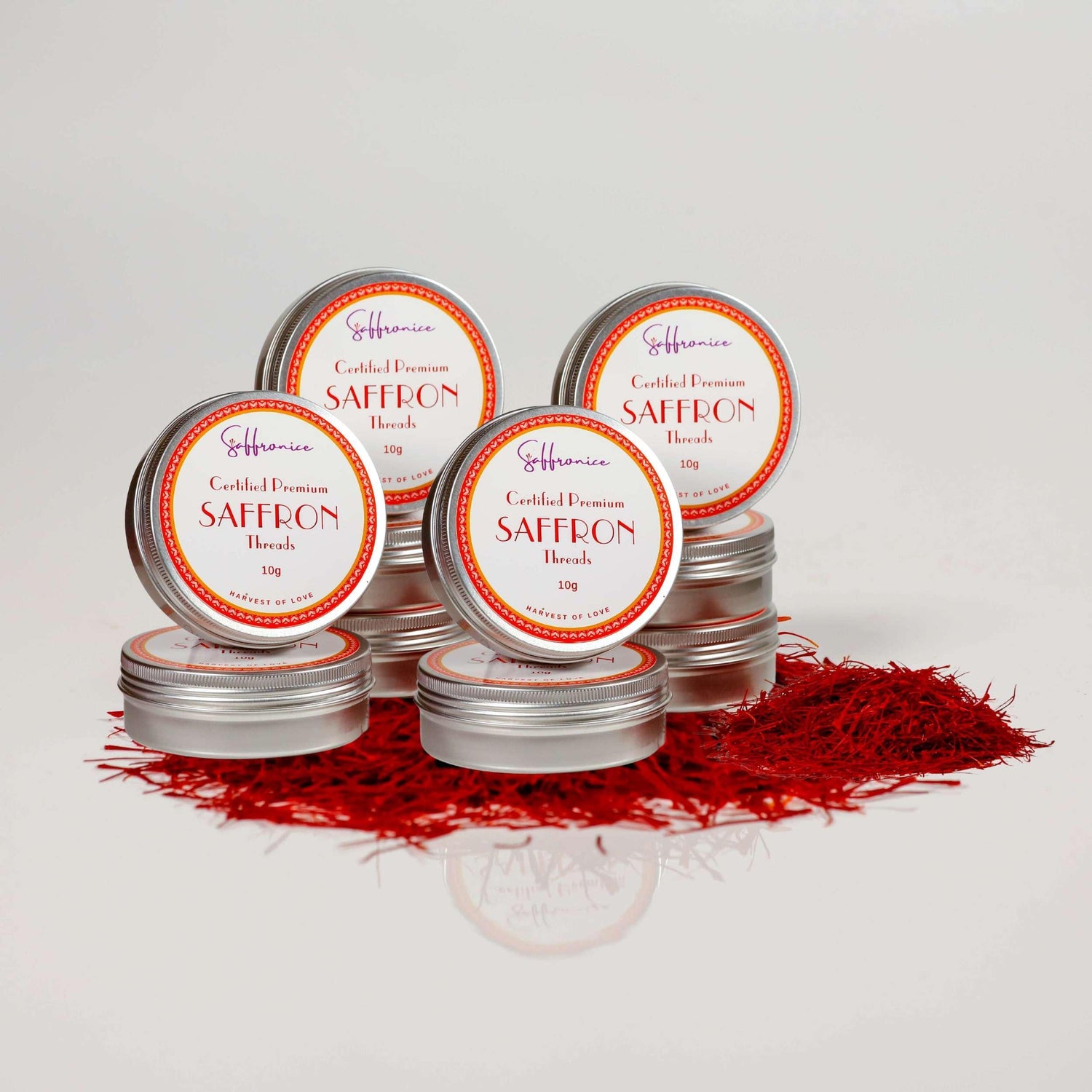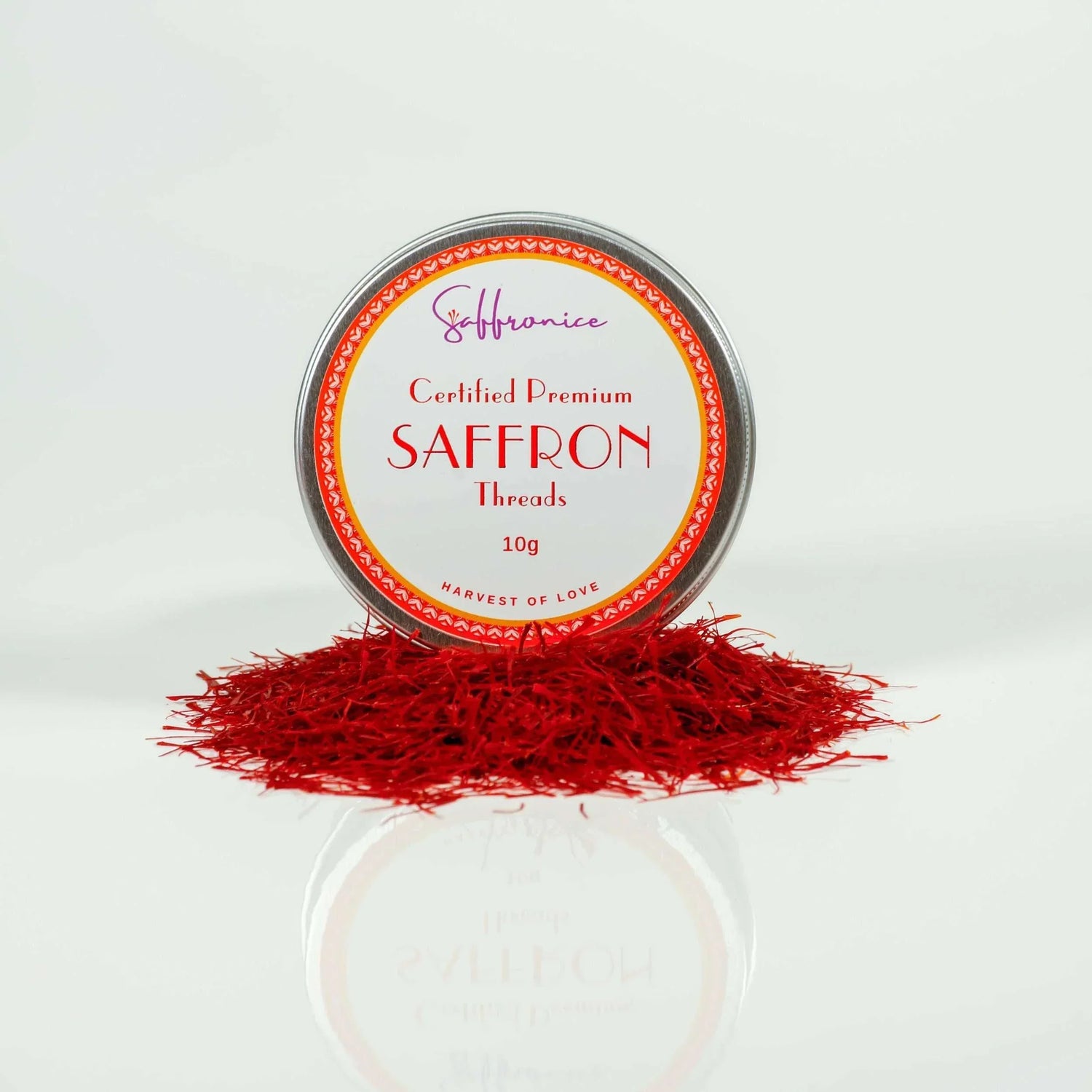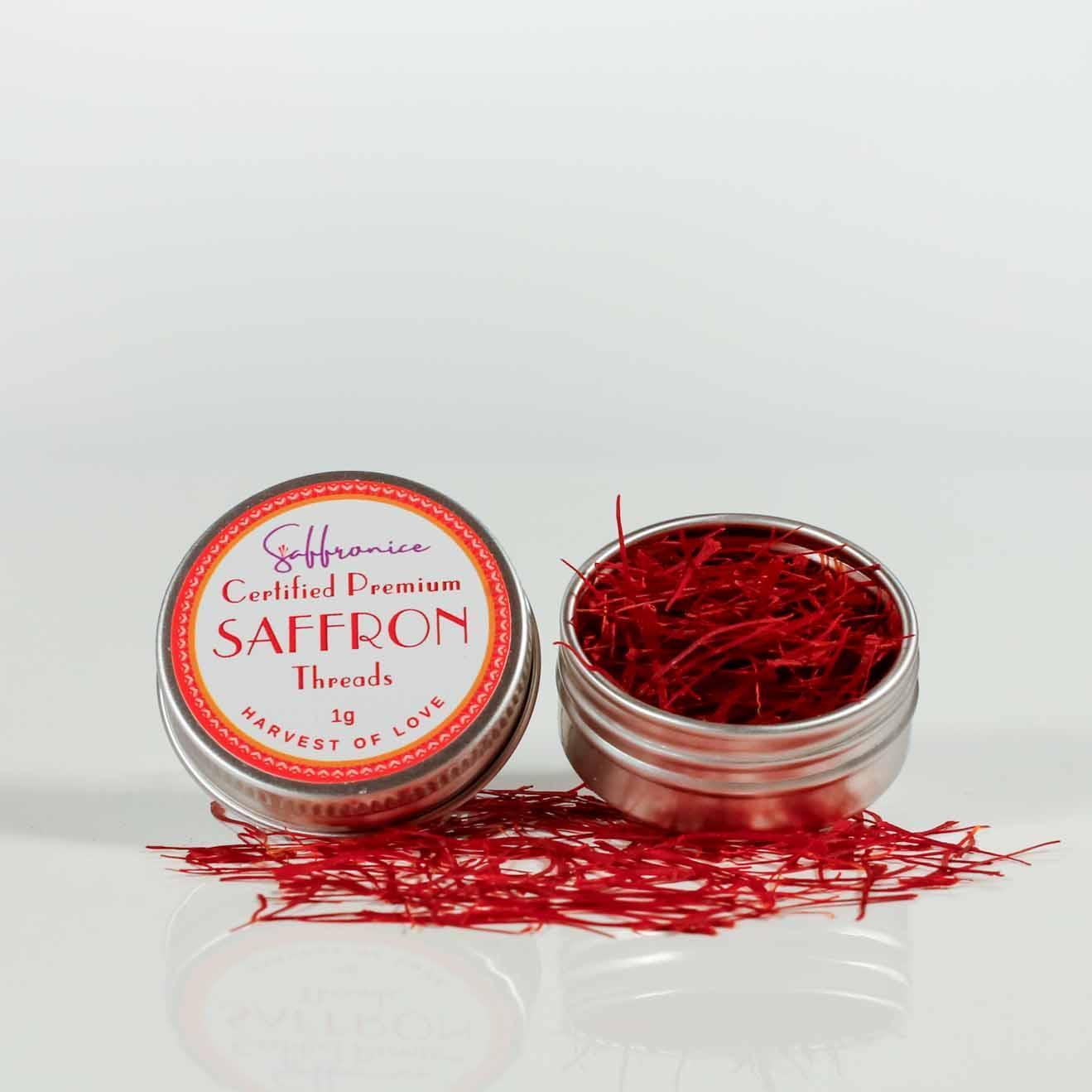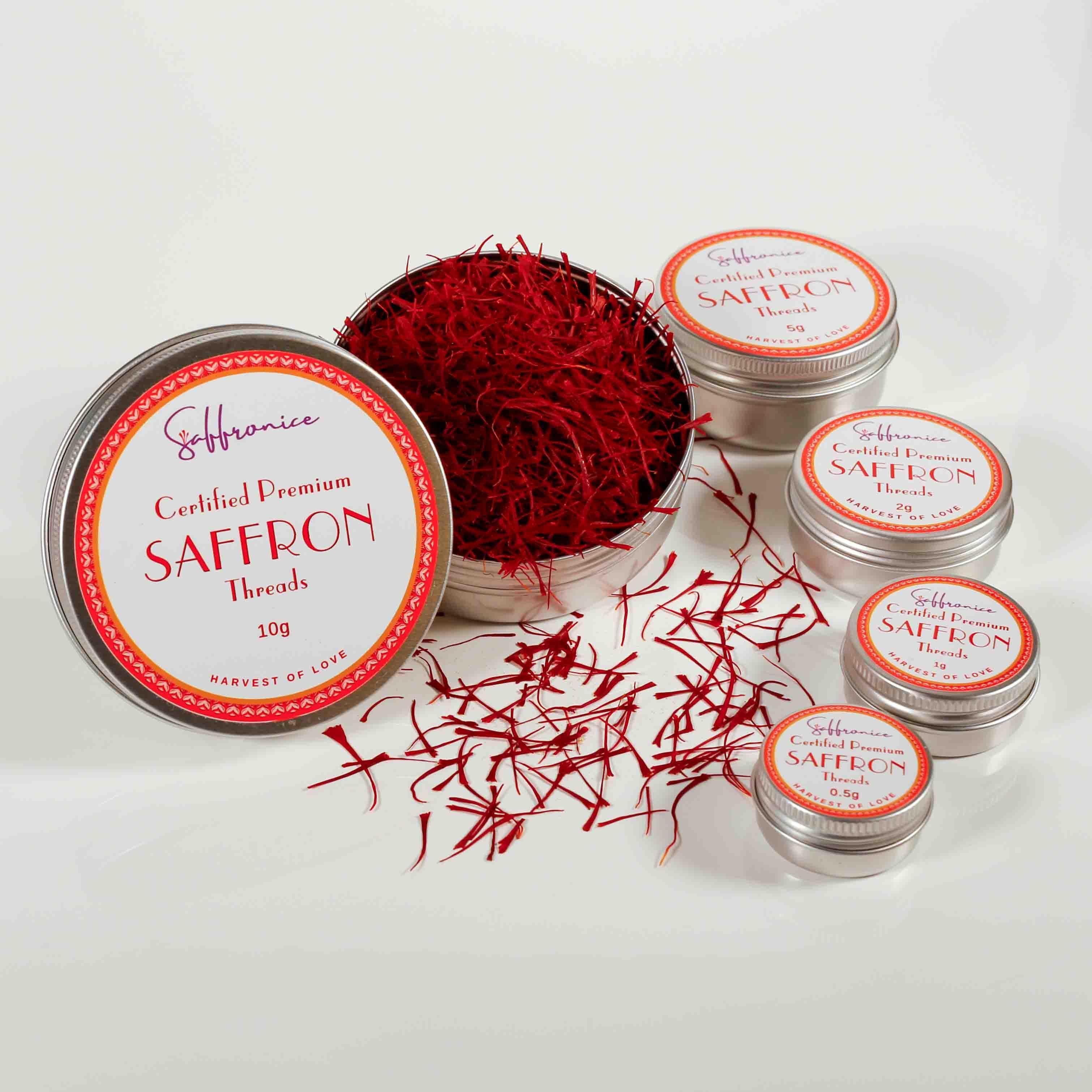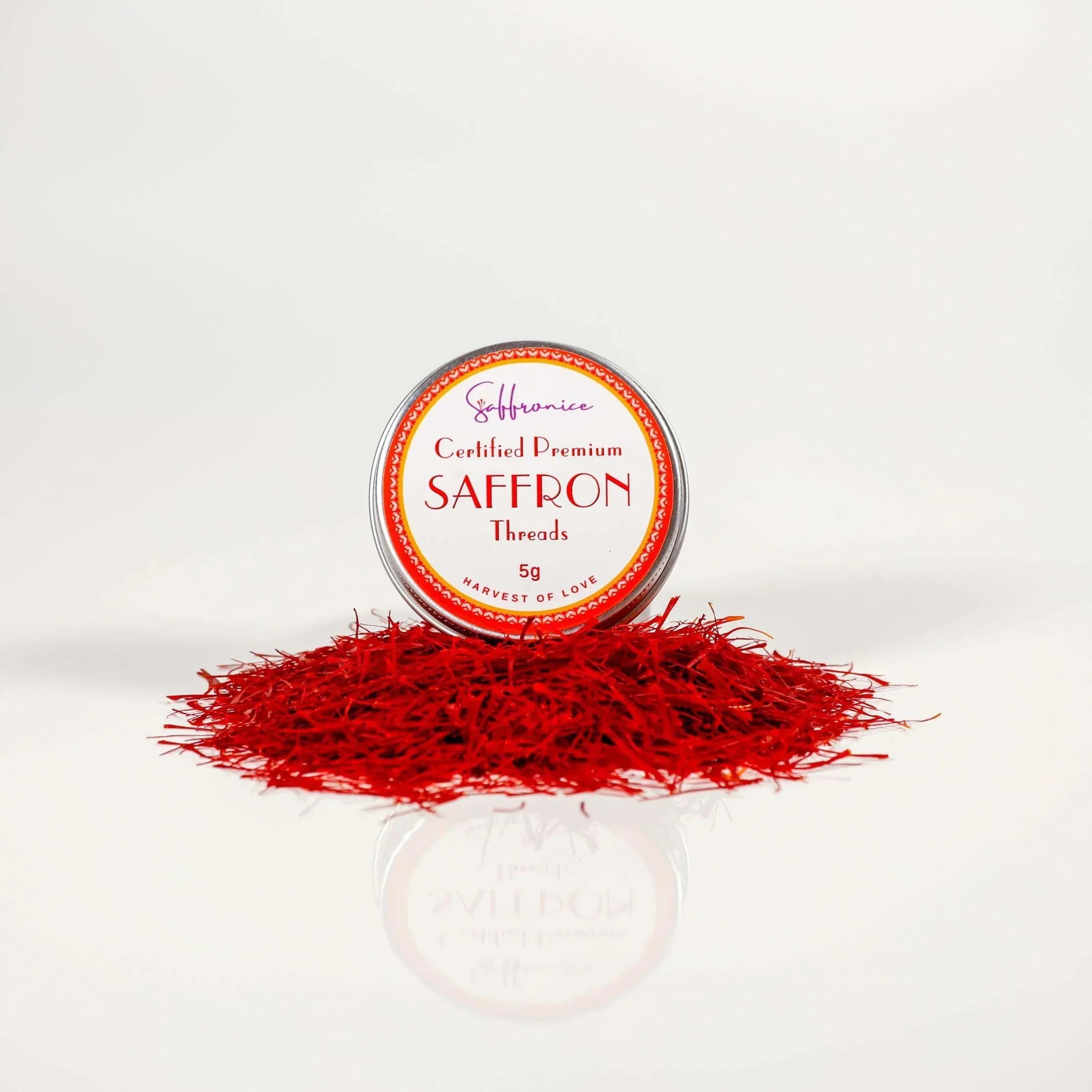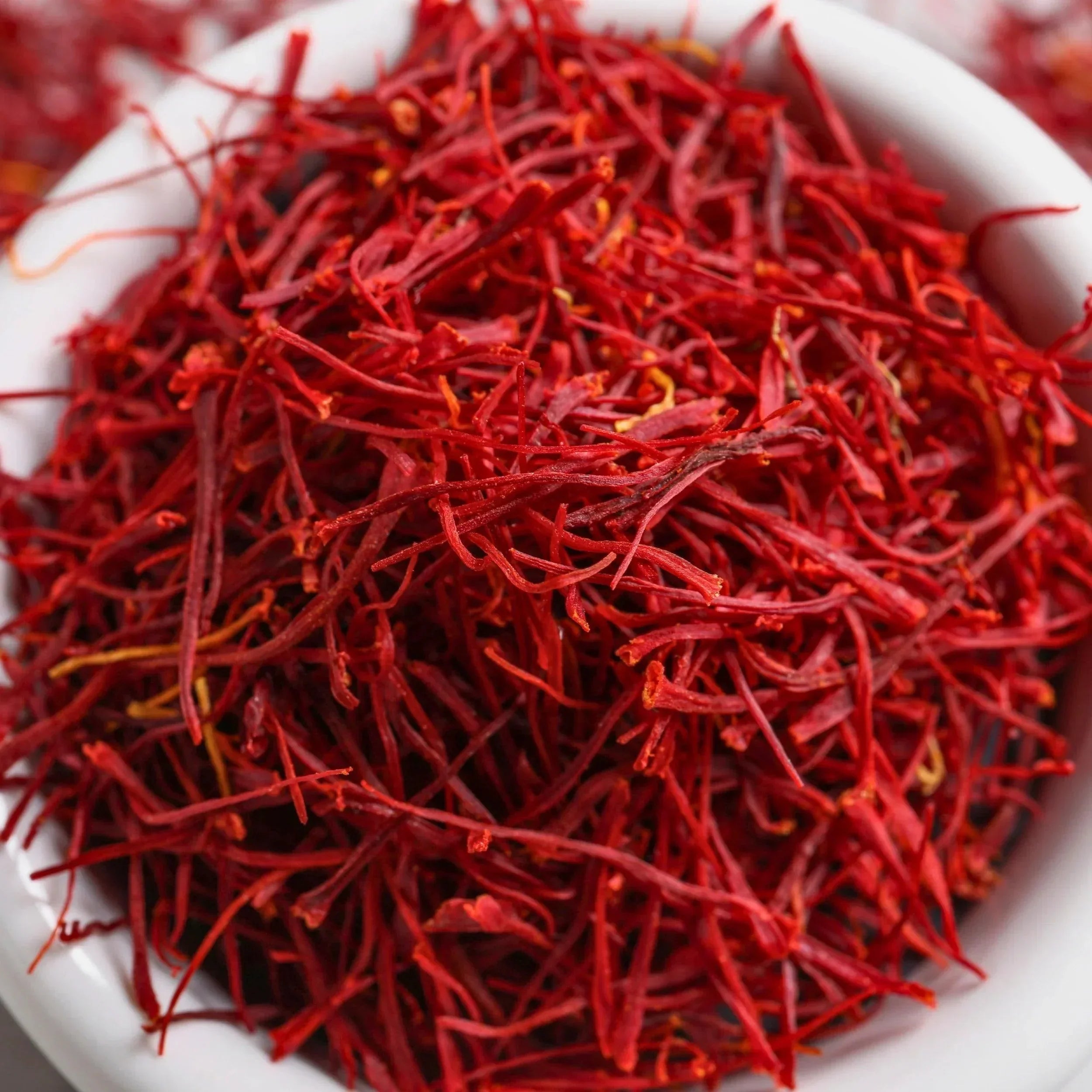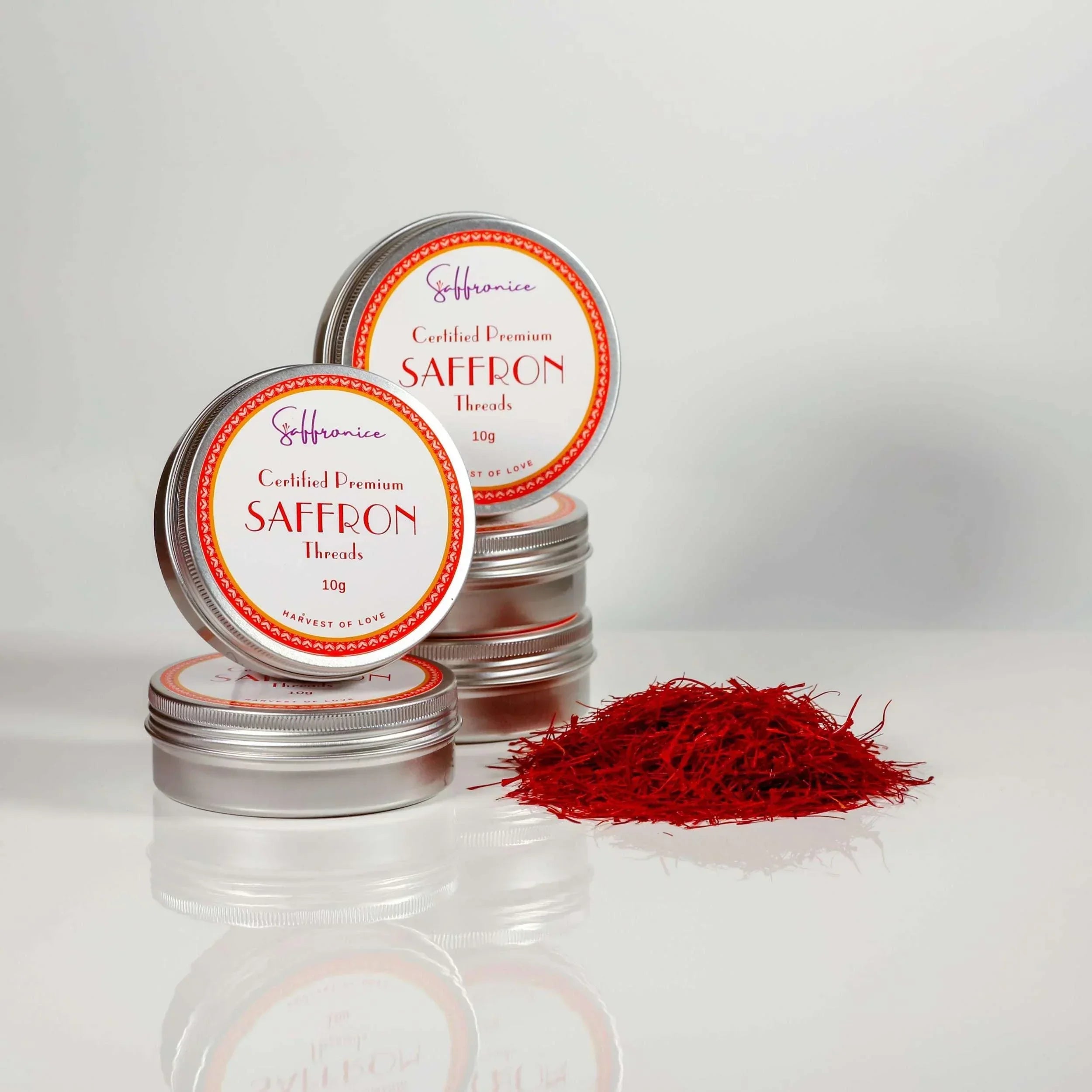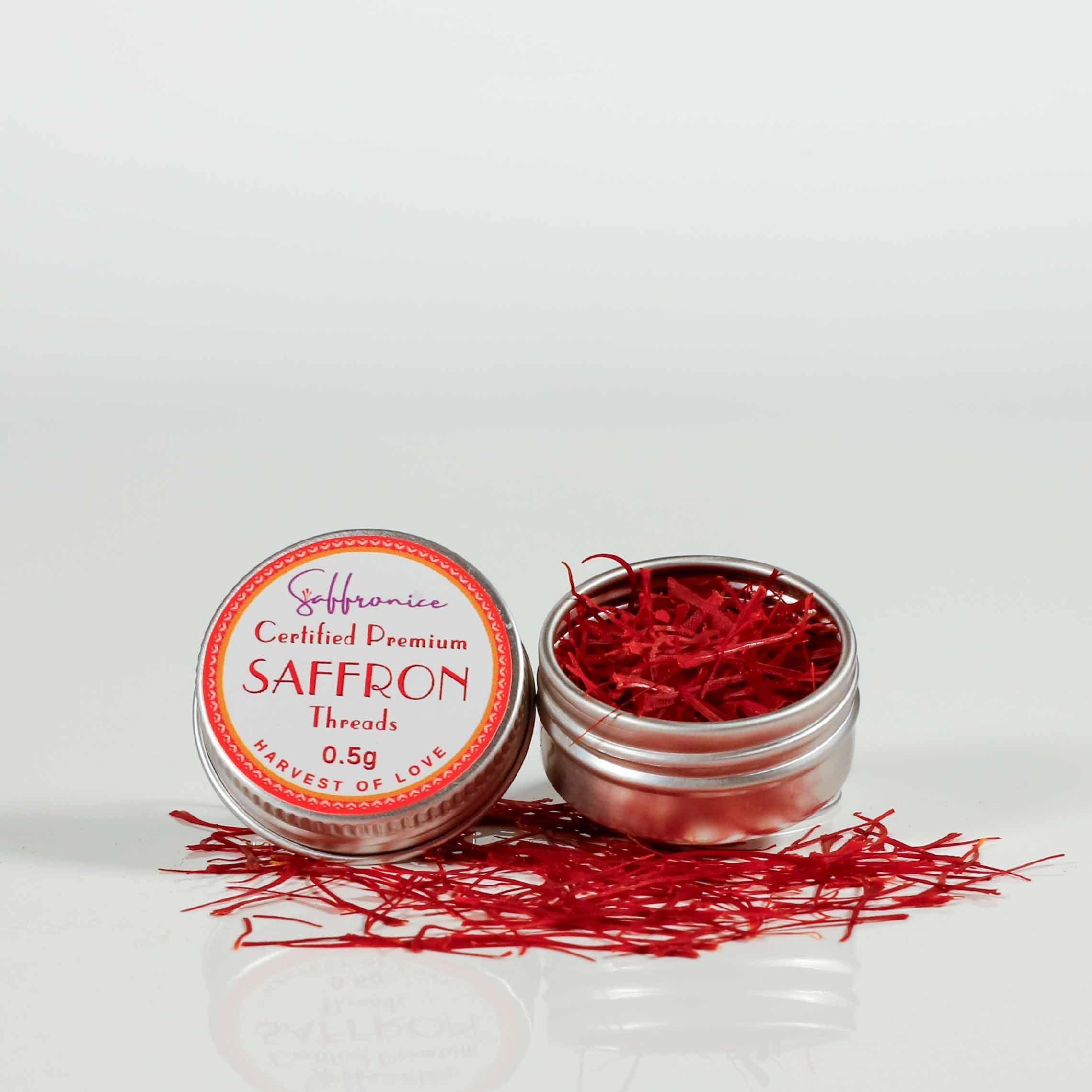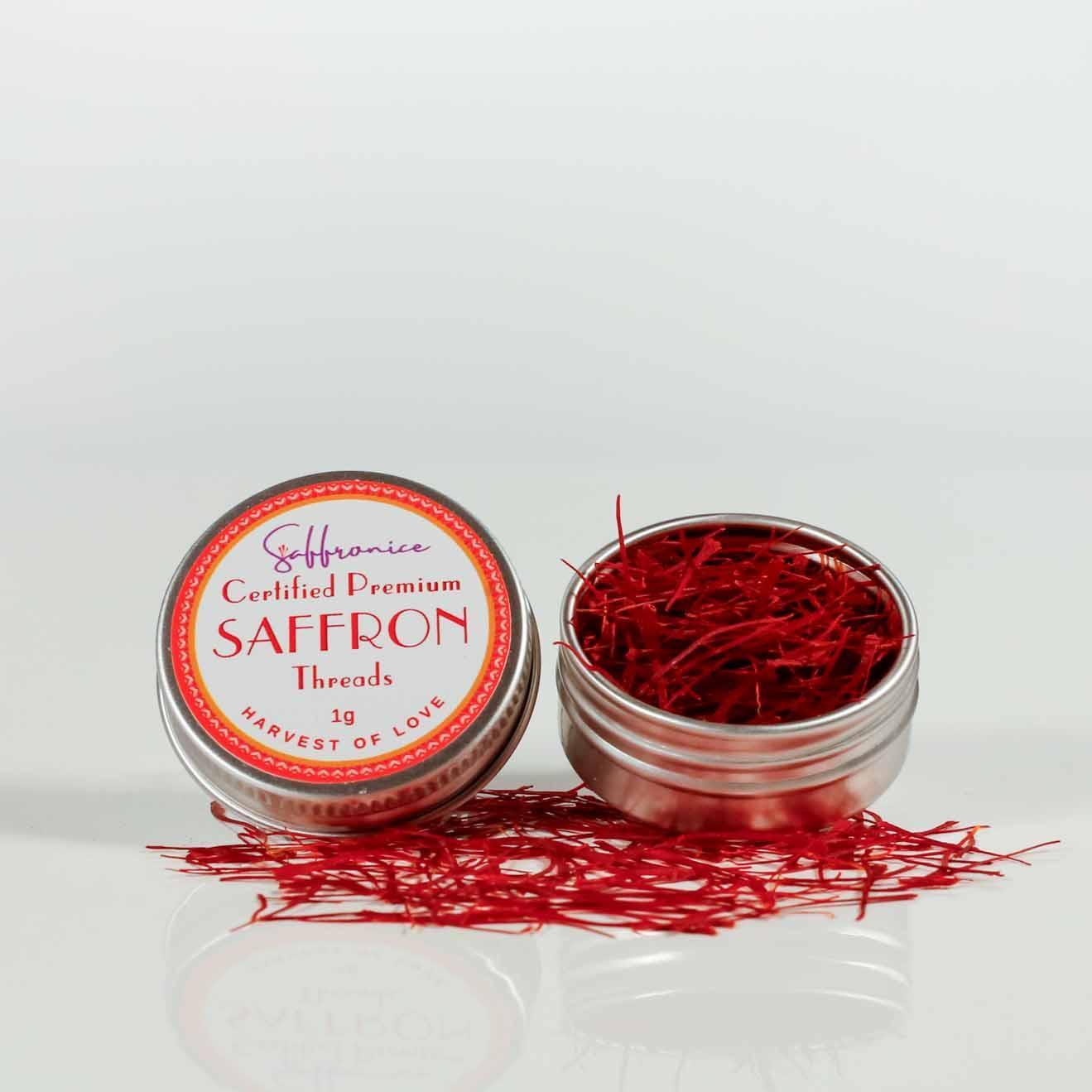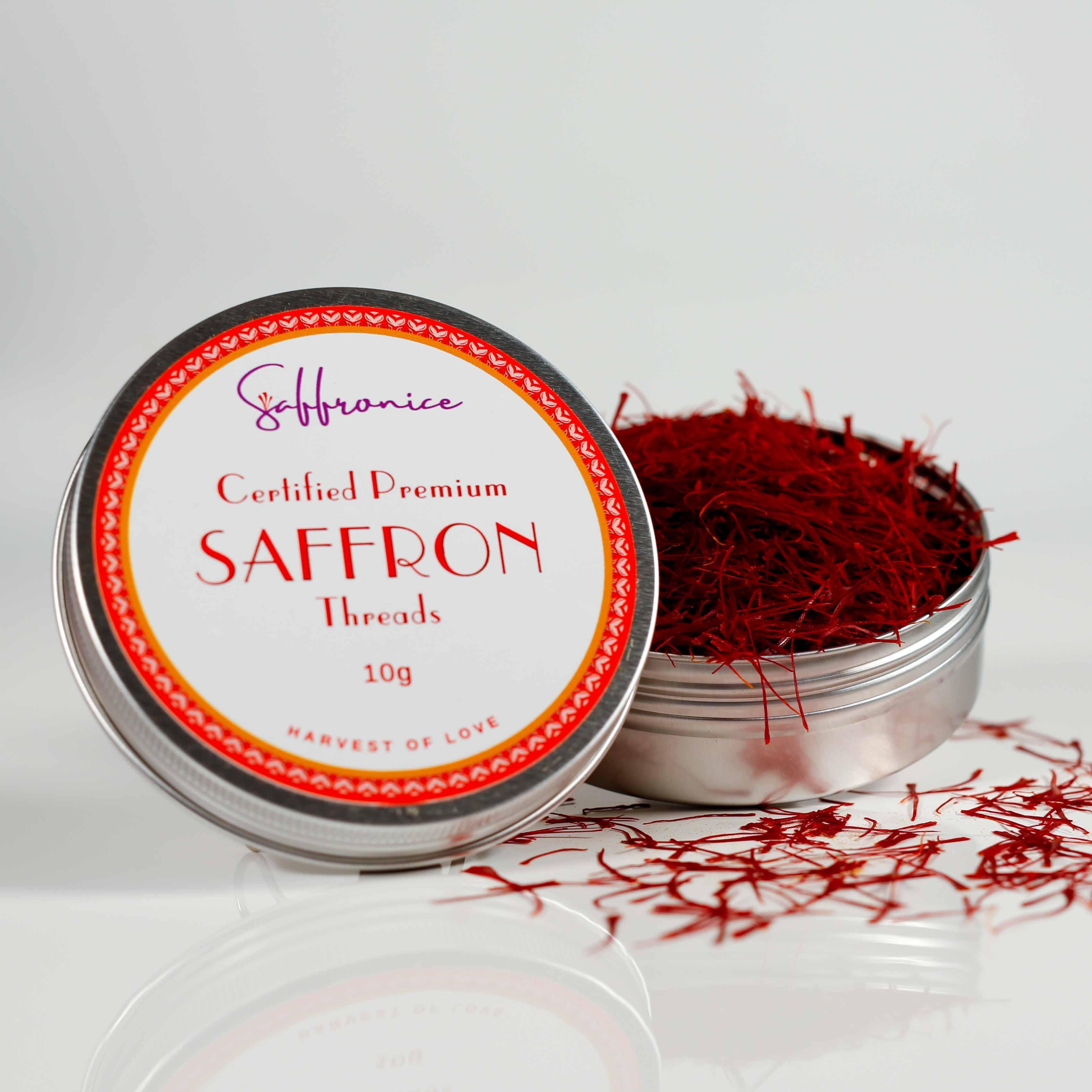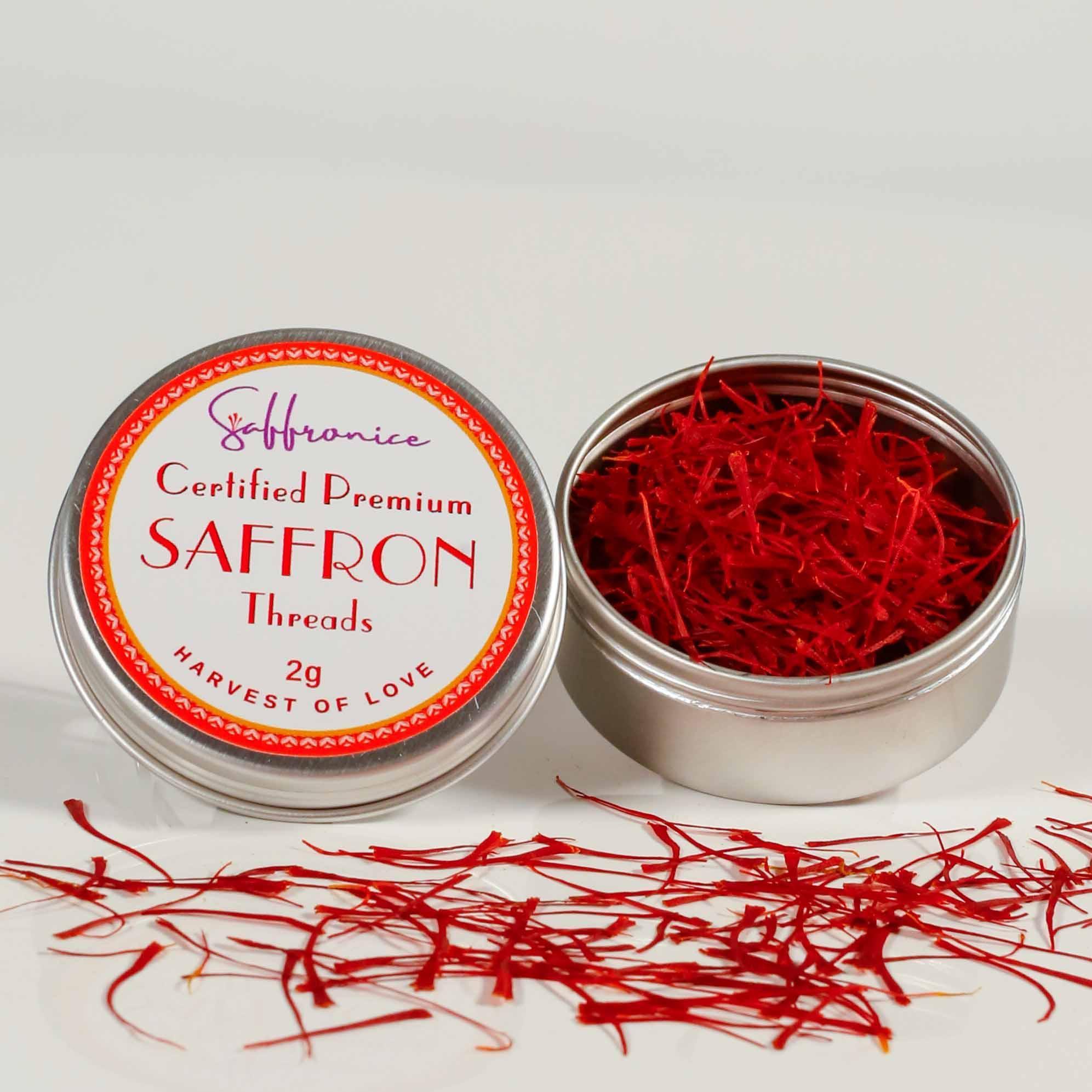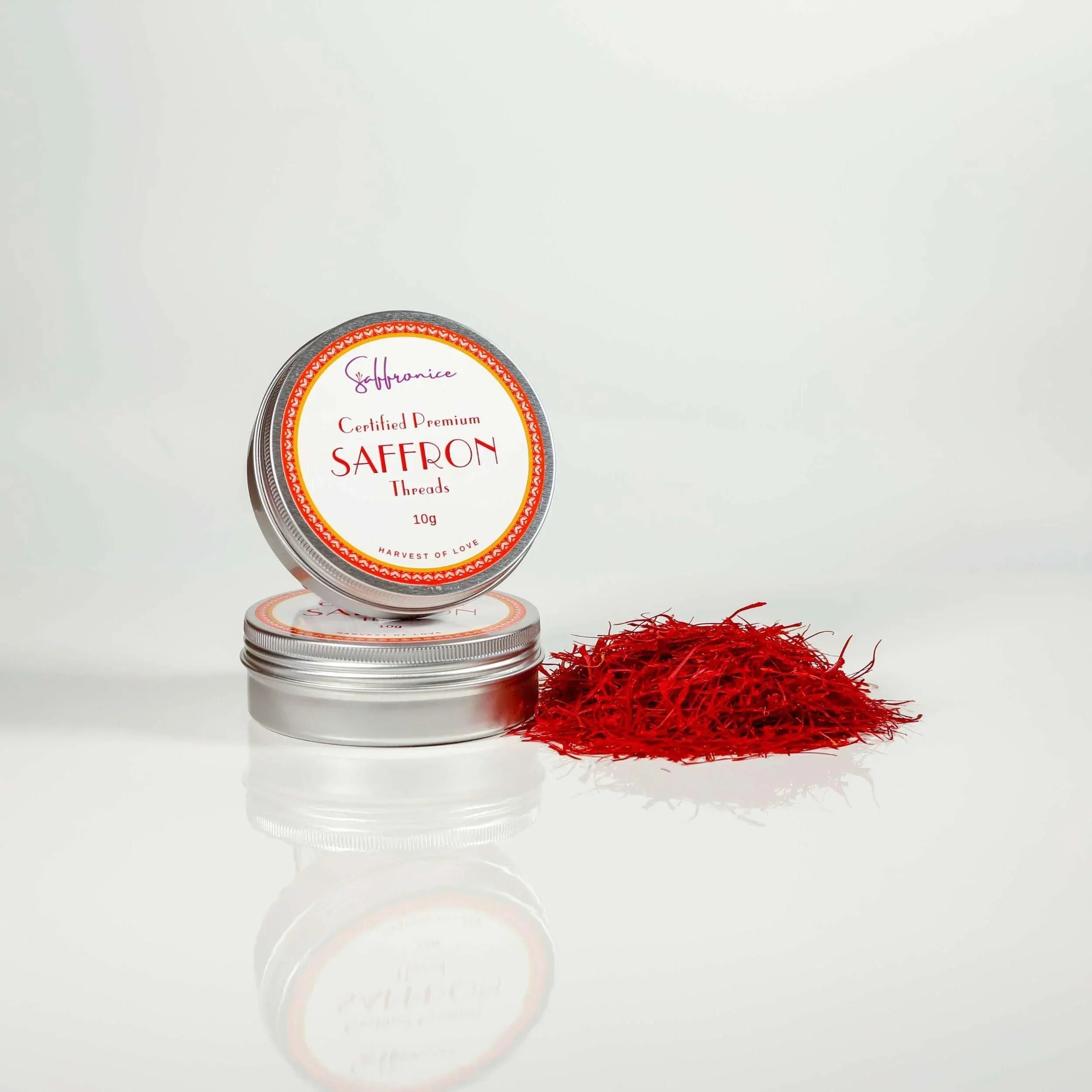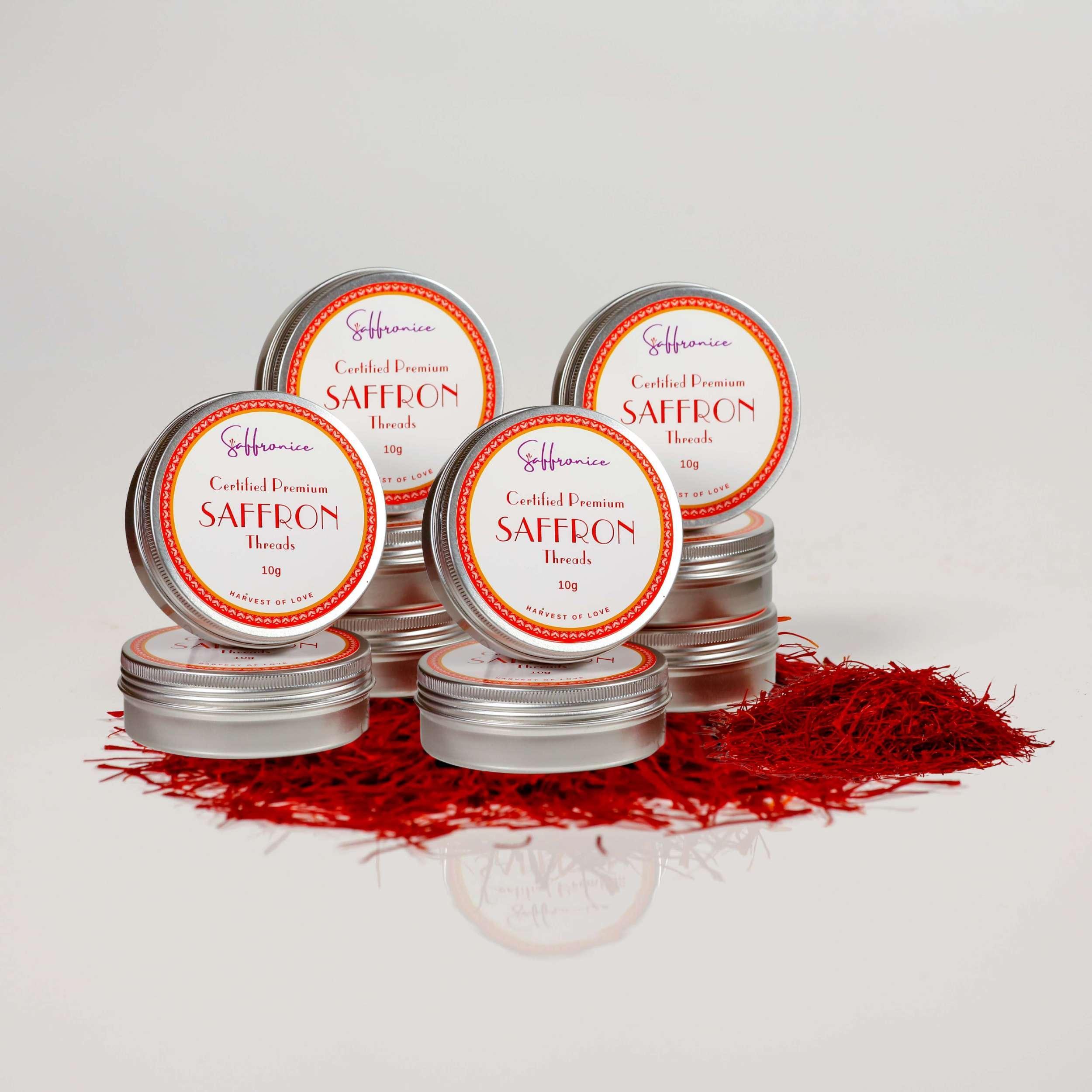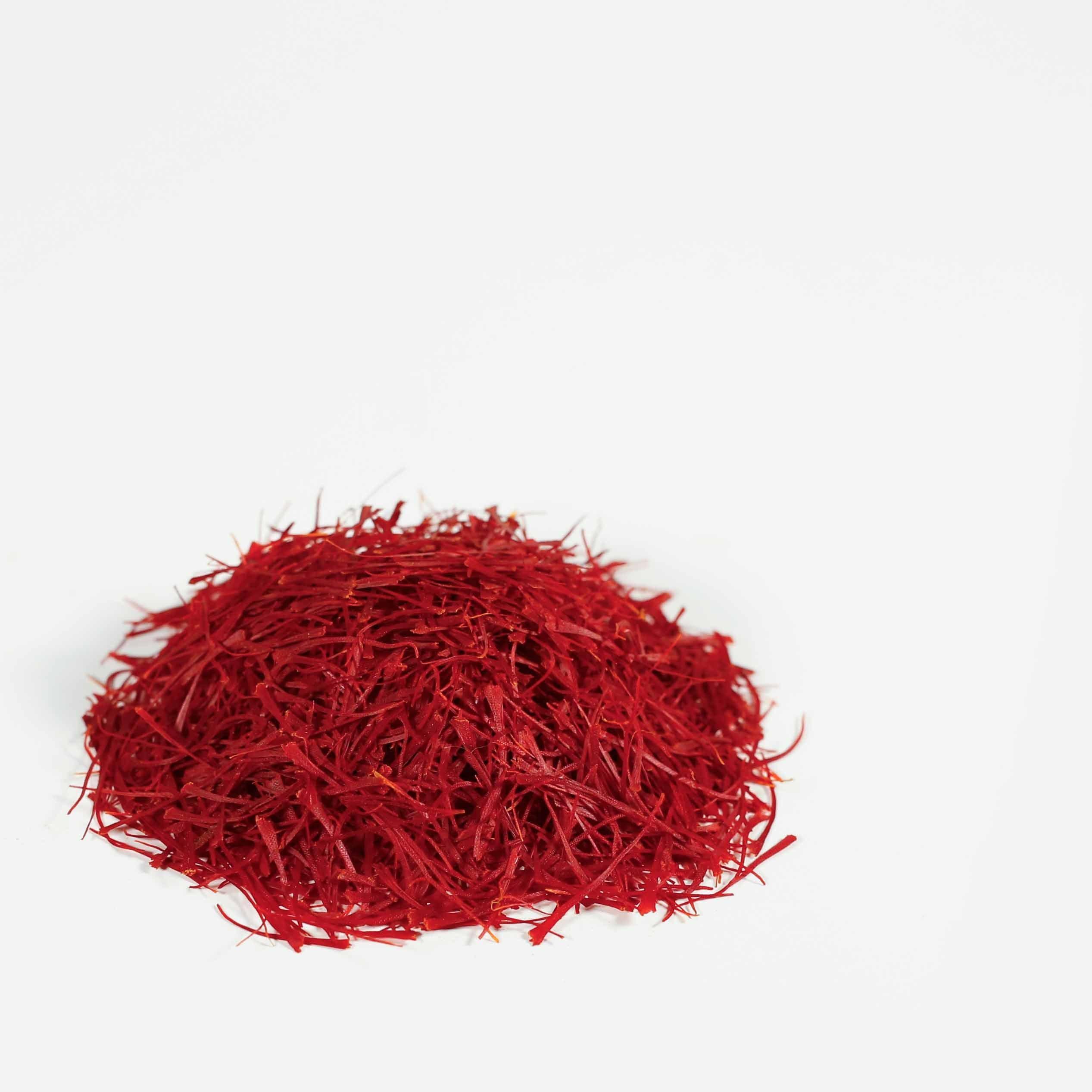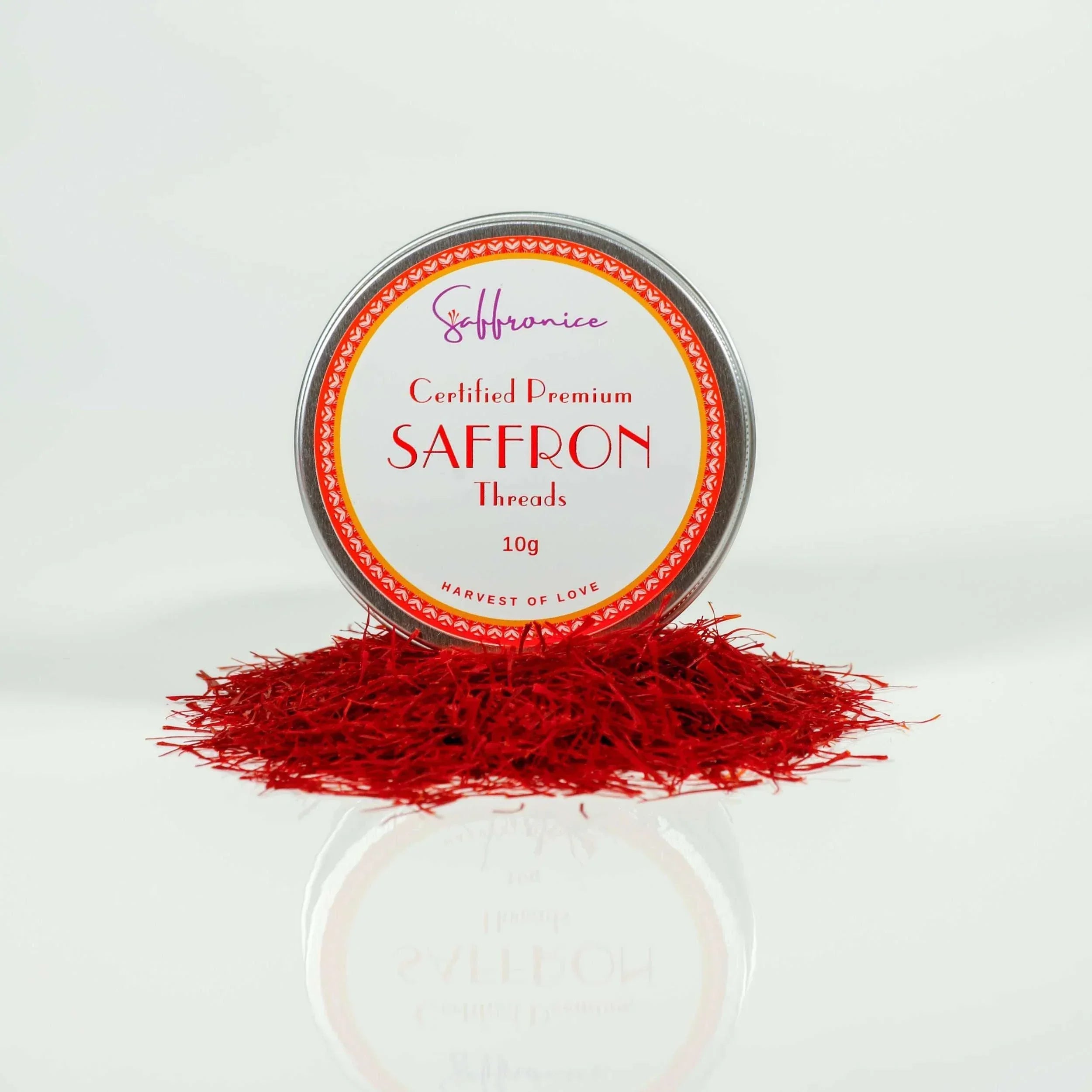Welcome to the fascinating world of saffron, a spice as rich in history as it is in flavour. Known for its distinctive golden hue and unique aroma, saffron, derived from the stigmas of the Crocus sativus flower, is more than just an exotic ingredient in our kitchens. Its value in culinary arts and beyond has made it a topic of great interest and admiration.
While many of our customers appreciate saffron for its remarkable culinary uses, we often receive queries about its other applications. We frequently hear, "How is saffron used outside of cooking?" In response, we've put together this article to shed light on the lesser-known but equally impressive uses of saffron. From its role in health and wellness to its presence in beauty treatments and cultural practices, we invite you to join us in exploring how this exceptional spice enriches our lives.

Medicinal Uses
-
Saffron, transcending its role as a mere spice, is integral in traditional and contemporary medicinal practices. Its application in health and wellness is a testament to its versatility and efficacy. Understanding how saffron is used for health can offer insights into the natural remedies that have been relied upon for centuries.
Traditional Medicine: Historically, saffron has been a staple in herbal medicine across various cultures. Its use in traditional healing practices spans from promoting digestive health to being a natural remedy for sleep disturbances. In some cultures, saffron has been prized for its potential to enhance heart health and circulation.
Contemporary Medicine: In modern medicinal contexts, saffron has garnered attention for its potential antidepressant properties. Studies have shown that certain compounds in saffron may positively impact mood regulation, offering a natural alternative for managing mild to moderate depression. This has positioned saffron as a subject of interest in mental health, where natural treatments are increasingly sought.
Anti-Inflammatory Properties: Another significant aspect of Saffron's medicinal use is its anti-inflammatory capabilities. The spice contains bio-active compounds that reduce inflammation. It is a beneficial adjunct in treating arthritis and other inflammatory diseases.
Cognitive Benefits: The cognitive-enhancing properties of saffron are also noteworthy. Research suggests that saffron may aid in improving memory and concentration, making it a potential aid in treating cognitive decline associated with ageing. Its neuroprotective qualities are being explored to support brain health and cognitive function.
In summary, how saffron is used in health and medicine reveals a multifaceted answer. From traditional remedies to modern clinical applications, saffron continues to demonstrate its value as more than just a culinary delight but a potent ally in health and wellness.

Cosmetic and Skincare Applications
-
The beauty world has long discovered the secret of saffron, incorporating it into various skincare regimes. But how exactly is saffron used in beauty treatments? Its rich content of antioxidants and unique compounds makes it an invaluable ingredient for skin health, particularly in anti-ageing and complexion enhancement.
Anti-Ageing: Saffron is revered for its ability to aid in the fight against ageing. The spice is rich in antioxidants, which help protect the skin from free radicals and environmental stressors that can lead to premature ageing. Regular use of saffron-infused products can help maintain skin's youthful resilience and reduce the appearance of fine lines and wrinkles.
Complexion Enhancement: Saffron's natural skin-toning properties make it a popular choice for improving complexion. It is known to assist in evening out skin tone, reducing pigmentation, and imparting a healthy glow to the skin. Its anti-inflammatory properties also make it beneficial for calming irritated or red skin.
DIY Saffron Skincare Recipes
Saffron and Honey Face Mask
-
Ingredients: A pinch of saffron (100mg), 1 tablespoon of honey, 2 tablespoons of milk.
-
Preparation: Soak saffron strands in the milk for a few hours. Mix in honey to create a paste.
-
Application: Apply the mask evenly on clean, dry skin. Leave it on for 20 minutes, then rinse with lukewarm water. This mask helps to hydrate and brighten the skin.
Saffron Toner for Radiant Skin
-
Ingredients: A pinch of saffron strands and 100ml of rose water.
-
Preparation: Infuse the saffron strands in rose water overnight.
-
Application: Use a cotton pad to apply the saffron-infused rose water on cleansed skin. This toner helps refresh and ton the skin while giving it a radiant glow.
Saffron Anti-Ageing Night Cream
-
Ingredients: A pinch of saffron (100mg), 1 tablespoon of aloe vera gel, and 2 teaspoons of almond oil.
-
Preparation: Crush the saffron into a powder form and soak the saffron powder in almond oil overnight. Mix the infused oil with aloe vera gel.
-
Application: Apply this blend as a night cream. This formulation works as a powerful anti-ageing moisturiser.
By incorporating saffron into your skincare regime, you can take advantage of its numerous benefits for skin health and beauty. These DIY recipes are simple yet effective ways to harness the natural power of saffron for healthier, more radiant skin.

Aromatherapy and Wellness
-
Saffron, distinguished not only by its flavour but also by its aromatic properties, plays a unique role in aromatherapy and wellness. A key question we often explore is, "How is saffron used to enhance our daily well-being?" The answer lies primarily in the simple yet profound act of smelling saffron and using products infused with its essence, such as our handmade saffron soaps.
Effects of Smelling Saffron Daily: Inhaling the aroma of saffron for a few minutes each day can have a surprisingly positive impact on mood and mental well-being. Saffron's natural fragrance is known to have mood-lifting properties. When inhaled, its scent is thought to stimulate the release of serotonin and dopamine. These neurotransmitters play a crucial role in mood regulation. This daily practice can help reduce stress and anxiety, nurture a sense of tranquil and easiness.
Handmade Saffron Soaps: At Saffronice, we have harnessed the aromatic benefits of saffron in our range of handmade saffron soaps. These soaps are not just cleansing products but therapeutic experiences. As you use the soap, the warm water releases Saffron's distinctive fragrance, transforming your daily shower into a moment of Zen. The natural aroma of saffron in our soaps can help calm the mind and uplift the spirit, making it an excellent addition to your morning or evening routine.
Integrating Saffron in Daily Life:
-
Morning Ritual: Start your day by using our saffron soap in your morning shower. The uplifting aroma of saffron can set a positive tone for the day ahead.
-
Evening Unwind: End your day with the soothing scent of saffron. Holding and smelling the saffron strands for a few minutes in a quiet space can help you unwind and relax after a busy day.
By incorporating the simple practice of smelling saffron or using our handmade saffron soaps into your daily routine, you can tap into this remarkable spice's natural, mood-enhancing benefits, adding a touch of serenity and joy to your everyday life.

Textile Dye
-
Saffron, celebrated for its culinary and medicinal properties, also holds a lesser-known role as a natural dye, particularly in the textile industry. "How is saffron used as a natural dye?" takes us back to its historical use in colouring fabrics.
Historical Significance: Historically, saffron was a prized commodity in the kitchen and the world of textiles. Due to its vibrant colour, saffron was used to dye cloths and garments, especially for royal and high-status attire. The rich golden-yellow hue that saffron imparts was often associated with wealth and prestige.
Process of Dyeing with Saffron: Using saffron as a dye involves soaking the saffron powder in water to release its colour. The fabric is then immersed in this saffron-infused water, absorbing the dye. Different intensities of yellow can be achieved depending on the concentration of saffron and the duration for which the cloth is soaked. The result is a naturally dyed fabric with a unique, radiant colour that stands the test of time.
Contemporary Use: In modern times, using saffron as a natural dye is less common due to the availability of synthetic dyes. However, it still exists in the niche organic and natural textile production market. Artisans and Eco-conscious designers occasionally turn to saffron for its natural, non-toxic dyeing properties, especially for speciality items where the allure of natural dyes is a crucial aspect.
Saffron's use as a natural dye in textiles is a testament to its versatility and historical significance. It demonstrates how this extraordinary spice has been valued for its flavour, health benefits, beauty, and utility in art and culture.

Cultural and Religious Significance
-
Saffron's value extends well beyond its culinary and medicinal uses, playing a significant role in various cultural and religious contexts. The question, "How is saffron used in cultural and religious rituals?" uncovers a rich tapestry of traditions where saffron is not just a spice but a symbol of purity, sacrifice, and divine offering.
In Religious Rituals: Across different religions, saffron has been used in rituals and ceremonies for centuries. In Buddhism, saffron is used to dye monks' robes, symbolising purity and renunciation. In Hinduism, it is an essential part of religious rituals. It is often used to mark the forehead during worship as a sign of holiness and to adorn the idols of deities. Saffron is also used to prepare special festive foods and sweets offered to gods during religious festivals.
Cultural Practices: Beyond religious rituals, saffron has deep cultural significance. In some regions, it is an integral part of wedding ceremonies, used in various rituals symbolising purity, fertility, and prosperity. Saffron's colour, reminiscent of the sunrise, is often associated with the promise of a new beginning, making it a cherished element in cultural celebrations.
Historical Art and Literature: The influence of saffron extends to historical art and literature, where it has been mentioned in ancient texts and depicted in artworks, highlighting its esteemed status in past civilisations.
Symbolism: Saffron's vibrant colour and rarity have made it a symbol of wealth and nobility. Its use in cultural and religious contexts often signifies a respect for tradition and a connection to the divine.
The cultural and religious significance of saffron illustrates how this remarkable spice has been revered and integrated into the very fabric of societies across the globe. Its presence in various traditions and rituals underscores its importance as a bridge between the mundane and the sacred, enriching cultural heritage and religious practices with unique attributes.

Gardening and Home Décor
-
When exploring the question, "How is saffron used in gardening and home décor?" we uncover the versatile nature of saffron that extends its charm to the realms of gardening enthusiasts and interior design aficionados.
Saffron Crocus in Gardening: The saffron crocus (Crocus sativus) from which saffron is harvested is valuable for its stigmas and as an ornamental plant in gardens. The plant blooms with beautiful purple flowers in autumn, providing a splash of colour when most other plants prepare for winter. Growing saffron crocus is an excellent way for gardening enthusiasts to add an exotic and functional element to their gardens. The plants are comparatively easy to grow and keep, thriving in well-drained soil and sunny locations.
Dried Saffron for Home Fragrance and Color: Beyond the garden, dried saffron can be used as a natural home décor element. Its vibrant strands can be displayed in small, transparent containers, adding a touch of elegance and colour to any room. Additionally, dried saffron can be used in potpourri blends, emitting a subtle and unique aroma that enhances the ambience of living spaces. Placed in decorative bowls or sachets, saffron serves as a fragrant element. It brings a piece of its rich history and cultural significance into homes.
Incorporating Saffron in Home Décor:
-
Table Settings: Use dried saffron strands as part of table centrepieces or place settings for special occasions, adding an exotic and sophisticated touch.
-
Fragrance Sachets: Create small sachets filled with dried saffron and other aromatic herbs to place in drawers or closets for a natural, pleasant scent.
-
Decorative Displays: Arrange dried saffron in glass vials or alongside other dried botanicals to create an exciting and colourful display.
In gardening and home decor, saffron serves as a spice and a means of bringing beauty, fragrance, and a touch of the exotic into our living spaces. Whether cultivating its flowers or using its dried form for decoration, saffron offers unique and creative ways to enhance our environments' aesthetic and sensory appeal.

Saffron in Crafts and Hobbies
-
Delving into the creative world of crafts and hobbies, saffron emerges as a vibrant medium for artistic expression. The inquiry into "how is saffron used in crafts" reveals its versatility as a natural dye and its potential to add a unique touch to various crafting projects.
Natural Dyeing Projects: Saffron's rich, golden hue makes it an excellent choice for natural dyeing projects. Craft enthusiasts can use saffron to impart a warm yellow colour to fabrics, yarns, and papers. The process involves creating a saffron-infused dye bath, where materials can be soaked to absorb the colour. This method is trendy among those who practice sustainable crafting, as it employs a non-toxic, environmentally friendly dyeing technique.
Fabric and Yarn Dyeing:
-
For fabric and yarn dyeing, saffron powder or strands are steeped in hot water to release their colour.
-
The fabric or yarn is then plunge in the dye bath, allowing the colour to transfer. This can be used for creating unique clothing, accessories, or home textiles.
Paper Crafts:
-
Saffron can also be used to dye paper, adding a distinctive touch to handmade cards, bookmarks, or scrap-booking projects.
-
The dye gives the paper a vintage, antique look, ideal for creating personalised and aesthetically pleasing craft items.
Saffron in Artwork:
-
Artists can incorporate saffron dye into their paintings or mixed media art, using it as a natural pigment.
-
This can add an incomparable concept to the artwork, especially when combined with other natural dyes.
Incorporating Saffron in Craft Workshops:
-
Crafting workshops can include sessions on using saffron for dyeing, offering a hands-on experience for participants to learn about natural dye techniques.
-
These workshops can be an excellent way to educate people about sustainable crafting methods while allowing them to explore their creativity.
Saffron's use in crafts and hobbies opens up a world of artistic possibilities, from fabric and paper dyeing to innovative art projects. Its natural colouring properties bring a touch of organic to crafting and allow enthusiasts to explore their creativity in an Eco-friendly way.

Side Effects and Considerations
-
While saffron is celebrated for its diverse uses and benefits, knowing its potential side effects and considerations is crucial. This knowledge is essential for anyone exploring how saffron is used across various domains, whether culinary, medicinal, or other applications.
Allergies: Like any natural product, saffron may contain pollen and cause allergic reactions in some individuals. Symptoms may include itching, hives, or dizziness. It's essential to test for allergic reactions, especially if using saffron in skincare products or when consuming it for the first time.
Pregnancy and Breastfeeding: Saffron should be used cautiously during pregnancy and breastfeeding. High doses can act as a uterine stimulant and may not be safe for pregnant women. As with any supplement, it's advisable to consult a healthcare provider before using saffron during pregnancy or while breastfeeding.
Interaction with Medications: Saffron may interact with certain medications, especially those for mood disorders and hypertension. It's necessary to consult a healthcare professional before using saffron medicinally, mainly if you are on medication.
Dosage Considerations: In dietary use, saffron is safe when consumed in food amounts. However, medicinal doses require careful consideration. High doses of saffron can be toxic and may result in dry mouth, anxiety, dizziness, or nausea. It's crucial to adhere to recommended dosages and to seek professional advice for medicinal use.
Quality and Purity: The quality and pureness of saffron are vital. Adulterated or low-quality saffron not only diminishes its efficacy but can also pose health risks. Purchasing saffron from reputable sources ensures you receive a pure, high-quality product.
Topical Use: When using saffron in skincare, it's best to do a spot test first to ensure there's no adverse reaction. Saffron's intense colour may also temporarily stain the skin or fabrics.
By understanding these side effects and considerations, users can enjoy the benefits of saffron while minimising potential risks. It's always prudent to err on the side of caution and seek professional advice when incorporating saffron into your lifestyle, especially for health-related uses.

Conclusion
As we've journeyed through the many facets of Saffron's application, from its traditional role in the kitchen to its use in modern medicine, beauty, crafts, and wellness practices, one thing becomes abundantly clear: saffron is a spice of remarkable versatility. Its journey from a culinary enhancer to a component of health and lifestyle products is a creed to its enduring appeal and varied nature.
Saffron's ability to transcend beyond the boundaries of cooking, enriching our lives in various unexpected ways, is truly remarkable. Whether lending its vibrant colour to textiles, enhancing our health, gracing our gardens, or adding a touch of luxury to our beauty routines, saffron continues to surprise and delight us with its myriad uses.
We encourage our readers to step beyond the familiar realms of saffron in the kitchen and explore its full potential. There's a world of saffron out there waiting to be discovered, offering more than just flavour – it's an experience for the senses, a boost for well-being, and a link to traditions and cultures around the globe.
As you delve into the diverse applications of saffron, let it inspire creativity, wellness, and a deeper appreciation for one of nature's most extraordinary gifts.
As you've seen, saffron is not just a spice but a canvas for creativity, a tool for wellness, and a link to rich traditions. Now, we invite you to bring the magic of saffron into your own life. Explore our diverse range of saffron products at Saffronice, where quality meets authenticity. Whether you're a culinary enthusiast, a wellness advocate, or someone who appreciates the finer things in life, our selection is sure to inspire and delight.
But our journey with saffron continues. We're eager to hear from you! Share with us how saffron has found a place in your life. Have you discovered a unique way to use saffron in your cooking, crafts, or wellness routines? You may have a family tradition or a personal story tied to this extraordinary spice. Your experiences and ideas are not just valuable to us – they're an inspiration to the entire Saffronice community.
Contact us on our website and social media platforms, or email us at hello@saffronice.com. Let's continue to explore the wonderful world of saffron together, sharing knowledge, experiences, and the endless possibilities that this timeless spice brings into our lives.
View Other Interesting Saffron Related Articles



